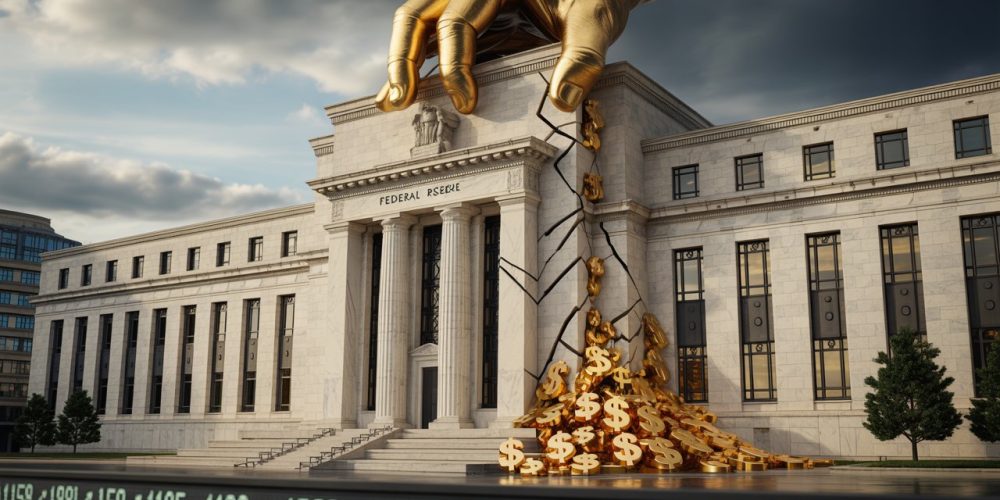
The markets, as I have often observed, seldom move without a narrative, but sometimes the narrative shifts so abruptly that even the most seasoned observers are left scrambling for a new script. This week, we saw precisely such a pivot. On October 20, 2025, I predicted that the Federal Reserve would cut interest rates by 25 basis points. That prediction has now materialized, and the implications of this second consecutive rate cut, coupled with the announcement to end Quantitative Tightening (QT), are profound. This is not merely a technical adjustment; it is a clear shift in the central bank’s priorities, a shift that I believe has been accelerated, if not outright dictated, by political calculus.
1. The Monetary Policy Declaration: A Dual Easing Strategy
The Federal Reserve has delivered an easing cocktail. The 25 bps rate reduction is significant enough, but when combined with the official decision to halt the reduction of their massive balance sheet, the total impact on market liquidity becomes exponentially greater. The explicit end to QT on December 1 is the quiet component of this policy move, but in financial terms, it is arguably the louder signal.
1.1. The Rate Cut: Supporting a Softening Labour Market
The decision to lower the federal funds rate for a second time is being publicly framed as a response to the softening labour market. We are seeing major firms announce thousands of layoffs, suggesting the tight job market of the recent past is loosening.
- The Mandate Conflict: The Fed’s dual mandate requires it to balance maximum employment and price stability. The current action shows a clear tilt towards the employment side of the scale. Officials have determined that the risk of a sharp decline in the job market outweighs the immediate danger of creeping inflation.
- The New Rate Trajectory: I anticipate that this is not the end of the easing cycle. My analysis suggests we will see another 25 bps rate cut within the current quarter. This aggressiveness is necessary to keep the market afloat, a necessity I believe is driven by factors beyond pure economic data.
1.2. The End of Quantitative Tightening (QT): A Liquidity Flood
Quantitative Tightening has been the silent killer of liquidity, having drained approximately $2.3 trillion from the financial system since 2022 by allowing bonds to mature without reinvestment. The decision to halt this on December 1 fundamentally changes the money supply equation.
- Mechanism: The Fed will cap Treasury rolloffs and reinvest maturing Mortgage-Backed Securities (MBS) into shorter-duration T-bills. This action is the functional equivalent of another rate cut in terms of adding cash to the market.
- Impact: This move immediately eases the current stresses in money market accounts. The injection of cash is a direct tailwind for financial markets, fostering an environment of cheaper long-term rates.
2. The Political Undercurrent: The Trump Factor
My analysis holds that this historic rate cut is directly influenced by external, non-economic pressures. The Federal Reserve, traditionally viewed as an independent body, appears to be acting under the distinct shadow of the current administration.
2.1. The President’s Pressure
The consistent and aggressive public pressure from President Trump, who has frequently demanded steep rate cuts and used his social media platform to call for aggressive easing, is a factor that cannot be ignored.
- Aligning the Action: The 25 bps cuts align perfectly with the administration’s demand for cheaper money. While the Fed resists the scale of the President’s full 50 bps demands, the direction of travel is undeniable.
- The Tariff Irony: The irony of this political influence is that the President’s tariffs are inflationary, pushing up core goods prices. Yet, the Fed is cutting rates anyway, effectively easing policy to offset the job hits caused by the administration’s own trade policies. The White House effectively wins on both trade and easing.
2.2. Governing Body Dissent
The deep divide within the Federal Open Market Committee (FOMC) underscores the extraordinary pressure. The fact that there were two dissents, with one likely being a push for a more aggressive 50 bps cut, demonstrates the difficulty of achieving consensus in this climate. The Fed is navigating a “data-blind” environment due to the ongoing government shutdown, making the role of politics and perceived risk management even more crucial.
3. Market and Inflationary Consequences
The dual easing policy creates a fascinating and potentially volatile setup for the economy, providing short-term gains but introducing significant long-term risks, particularly regarding price stability.
3.1. Short-Term Market Effects: A Bullish Boost
The initial market response, as is often the case with an unexpected liquidity injection, was positive.
- Stocks and Bonds: Stocks received a bullish boost, and bonds rallied. Cheaper borrowing costs are advantageous for refinancing and for the housing market.
- Crypto and Risk Assets: The crypto market, after an initial unpleasant reaction that I noted, is likely to find its footing. The end of QT and the ensuing liquidity unlock are fundamentally supportive of speculative, risk assets. The historical tendency of these markets to settle once the dust has settled suggests a surge is probable as money seeks higher yields outside of traditional, now less attractive, accounts.
- Initial Response Volatility: The temporary volatility in crypto after the news is typical of markets trying to price in competing narratives: a rate cut signals economic weakness, which is bad, but a massive liquidity injection is good. The latter will ultimately prevail.
3.2. Inflation: The Persistent, Sticky Problem
The Achilles’ heel of this new policy stance is inflation. The Fed is tolerating a level of price pressure that would have been unacceptable just a year ago.
- Current Metrics: The Consumer Price Index (CPI) is sitting at roughly 3% year over year. While this is down from its peak, it is still stubbornly above the Fed’s 2% target.
- Reignition Risk: My central concern is the reignition risk. Easier money combined with factors like persistent tariffs (adding around 0.7 percentage points of pressure) and substantial investment in the AI bubble could push the core Personal Consumption Expenditures (PCE) index well above 3%. The Fed is betting on a soft landing where job cooling naturally reduces price pressures, but I maintain that tackling inflation will be hard to tackle given the need for aggressive rate cuts to please the President and keep markets moving.
4. Forward Guidance and Near-Term Vulnerabilities
The path ahead is marked by extreme uncertainty, driven by a lack of reliable data and heightened political risk.
4.1. The Data Blackout and Future Cuts
The government shutdown is the immediate, overriding vulnerability. It has resulted in a data-blind environment where the Fed must make critical decisions without reliable jobs or inflation reports.
- December Outlook: Markets were pricing in a decent chance of a December cut, though this has been moderated by cautious statements. The incoming data, once the shutdown ends, will be the true determinant. I still expect a total near-term easing of 50 to 75 bps if the jobs market continues its softening trend.
- The 2026 View: Beyond the near-term, markets are eyeing another 1.0 to 1.5% in total cuts through 2026. This is an aggressive expectation that suggests the market believes the Fed’s pivot has a long way to run.
4.2. Other Macroeconomic Factors
Several concurrent factors are amplifying the risk and complexity of the current environment.
- Dollar Weakness: The easing policy generally contributes to a weaker dollar, which can boost exports and manufacturing employment, a desirable outcome for the administration.
- AI Bubble Speculation: The roar of investments into artificial intelligence technology is creating a boom, but also the risk of overheating in certain sectors. A significant correction here could rapidly transmit stress across the broader financial system.
5. My Conclusion and Outlook: Bullish Liquidity, Enduring Risk
The central bank has executed a bullish liquidity pivot. The combination of the rate cut and the QT cessation is highly supportive of equity markets, corporate refinancing, and the broader risk-asset universe. The President’s pressure appears to have accelerated this timeline, forcing the Fed to prioritize financial stability and employment optics over a strict adherence to their inflation target.
- Outlook: A soft landing is probable because the massive inflow of liquidity will support growth. The risk of stagflation is low for now, but the long-term danger of entrenched inflation, fueled by tariffs and an environment of perpetual easing, remains the primary threat.
The astute investor must now calibrate their strategy not just for an environment of lower rates, but for one of continuous, politically-motivated liquidity injections. This is a game of managing volatility and capitalizing on the growth impulse, all while hedging against the eventual, inevitable cost of sticky inflation.


